Clancy Tucker's Blog, page 24
March 25, 2022
8 May 2022 - MILLENNIUM BRIDGE- INDONESIA

MILLENNIUM BRIDGE
- INDONESIA -
G'day folks,
One of the largest bamboo bridges in Asia, located right next to a bamboo school.One of the largest bamboo bridges in Asia is part of an even larger effort in Sibang Kaja, Bali, to combine modern ideas about green living and traditional uses of bamboo.
The Millennium Bridge extends 75 feet (23 meters) from one side of the Ayung River to the other. It is connected to the Green School, an ecologically sustainable complex that’s also made out of bamboo, as well as mud and local grasses. Nearby, there is a community of bamboo houses.


These projects, created by the team at IBUKU, an organization dedicated to beautiful and natural building, demonstrate how bamboo can be used as a renewable alternative to concrete or steel, to which it has comparable strength, though is more susceptible to the elements.
The bridge, which has a floor area of 230 square feet (70 square meters), took eight months to construct, and was completed in December of 2011. The roof of the covered bridge is inspired by the architecture of the Minangkabau people of Indonesia. In addition to being a means of crossing the Ayung River, the Millennium Bridge can also be rented as a scenic place for events. Up to 30 people can be accommodated on the bridge.
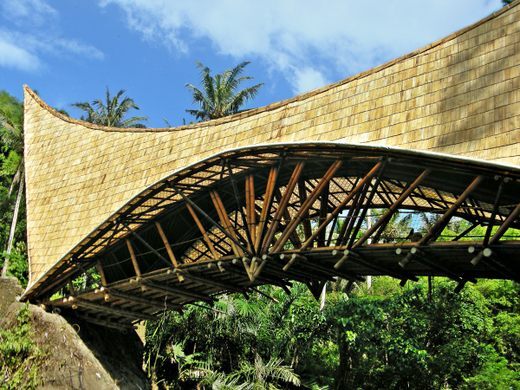
Clancy's comment: The manner in which bamboo is used in Asia is extraordinary.
I'm ...


7 May 2022 - ABANDONED RAILWAY TUNNEL IN SWEDEN
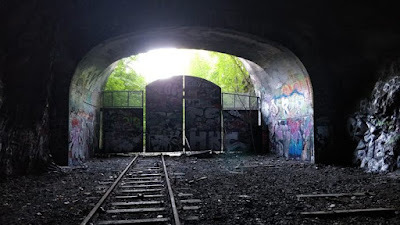
ABANDONED RAILWAY
TUNNEL IN SWEDEN
G'day folks,
It was meant to help transport wounded soldiers to a secret underground hospital.An old overgrown train track and tunnel with an intriguing history hide close to one of Stockholm’s most popular bathhouses.
The old industry track was built between 1925 and 1940. It stretches from the top northeastern tip of the Södermalm and arcs to the southwest. It begins near the harbor, as the idea was that wounded men arriving via ship to the harbor could be ferried away to an underground disaster center hidden beneath the hospital.

But no ships full of wounded World War II soldiers ever arrived. The railway did see some violence, though, as it was one of the places bombed by the Soviets during the February bombings of 1944.
The city has made several requests to remove the train tracks to construct houses in their place. The request keeps being denied, leading the city to find other uses for the space. Marathons have been held there, as well as theater shows and art exhibits. Proposed plans for the tunnel include a pedestrian path, concert hall, and even a ski trail.

Clancy's comment: It always staggers me when I read about the infrastructures constructed during our major wars.
I'm ...


6 May 2022 - THE OSTWALL FORTIFICATION - POLAND

THE OSTWALL FORTIFICATION
- POLAND -
G'day folks,
What was once an underground Nazi city is now Europe's largest bat reserve.When the Nazis built the imposting Ostwall Fortification in the mid-1930s the intention was to create a defense against invading Russian forces, but they clearly could not have foreseen the invasion of bats that would overtake the tunnels once they were abandoned.
The Ostwall Fortification, otherwise known as the tongue twisting “Festungsfront Oder-Warthe-Bogen,” was constructed as a massive self-sufficient bunker defense system that was connected by almost 25 miles of tunnels and underground support chambers. The underground complex connected around a hundred pillbox bunkers creating one of the largest and most extensive defense lines Nazi Germany ever created. It was estimated that at full capacity and operation the system could house 24,000 soldiers comfortably.



The bunker system was seen as a bit of a revolutionary endeavor at the time, both in terms of efficiency and efficacy. However when the attack on the base actually came, there were just 1,000 soldiers manning the massive defense. The Nazi’s impressive defensive juggernaut fell in just three days.
After the Nazi’s fled from their bunker city the site was essentially abandoned by humans but became home to some new tenants: tens of thousands of bats! Attracted to the tunnels thanks to the dark, temperate atmosphere and shelter for their winter hibernation, the flying mammals took to the tunnels in droves.
Today the tunnel complex has become the largest man-made bat reserve in Europe, holding around 37,000 bats during the packed winters during which tourists are not allowed in the tunnels. Many portions of the tunnels are open to visitors at other times of the year, but during bat season the Ostwall Fortification provides a safe space for the animals to rest defended from the outside world. The Nazis could only have wished it would’ve been so effective for them.

Clancy's comment: The Nazis built extraordinary infrastructures during the war, many of which were never fully used.
I'm ...


5 May 2022 - THE HIDDEN SECRETS OF VIS ISLAND, CROATIA
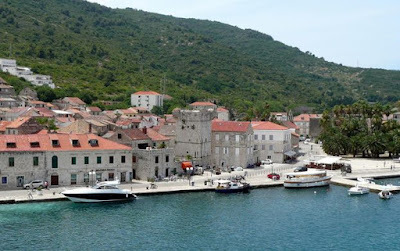
THE HIDDEN SECRETS OF
VIS ISLAND, CROATIA
G'day folks,
Formerly Yugoslavia's "forbidden island," this sleepy little city still holds the abandoned remains of military strongholds.While the Croatian island of Vis, the furthest from the mainland, has been inhabited for centuries it was not until the mid-20th century that it reached a pinnacle of strategic importance, a time that is still remembered by the handful of abandoned and repurposed military installations throughout the now quiet island.
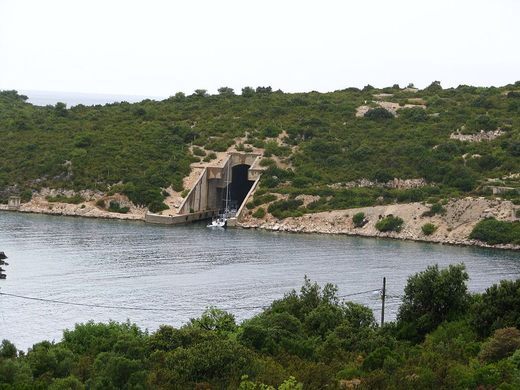
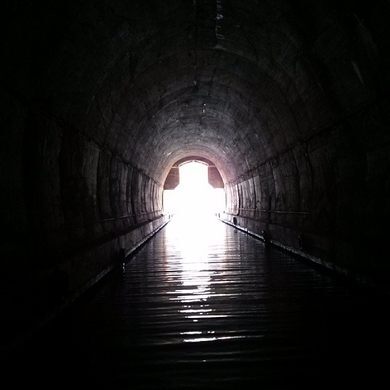

While had been inhabited for hundreds of years previous, it was during World War II that Vis came under the control of Yugoslavian leader Josip Broz Tito, who began establishing new military fortifications around the island. The site had been the home of previous military bases as well, but it was not until Tito took the island for Yugoslavia that most of the major remaining structures were created. After WWII ended the island officially went to Yugoslavia and their army made it their central naval base, installing such features as an imposing concrete submarine dock that led right into the island hills, and long tunnels that ran under the surface. However when the island reverted to Croatian control in the early 1990’s, most of the structures were simply abandoned.
Since the military use of the Vis installations ceased, many of the remaining structures were repurposed for civilian needs, while others simply remained empty. Today, Vis is a sleepy island that actually makes a fair amount of revenue from tourists eager to see the disregarded Cold War-era installations, as well as some of the islands more ancient features such as the classical artifacts displayed in the island’s central museum (itself housed in a disused base).

Clancy's comment: What a charming place for an author.
I'm ...


4 May 2022 - BULLET HOLE MEMORIAL - BUDAPEST
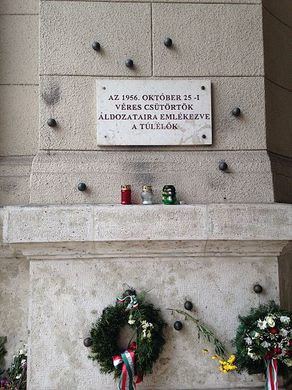
BULLET HOLE MEMORIAL
- BUDAPEST -
G'day folks,
This easily overlooked memorial immortalizes the scars from the 1956 Hungarian Revolution.In one of the most tourist-heavy sections of Budapest, a memorial to one of Hungary’s greatest national tragedies could easily go unnoticed.
The Ministry of Agriculture Building, located along the Kossuth Lajos Square and directly across from Budapest’s iconic Parliament Building, was the backdrop for a pivotal moment in Hungary’s 1956 Revolution against Soviet control.
On October 25, now known to Hungarians as Bloody Thursday, scores of spirited yet peaceful protesters congregated at the Parliament Building. To quell the mounting demonstration, Soviet troops and state secret police opened fire on the crowd of several thousand people. Some of the fleeing protesters took shelter behind the façade of the Ministry of Agriculture Building’s colonnade, and as a result, their pursuers fired in their direction, scarring the structure’s exterior in the process.
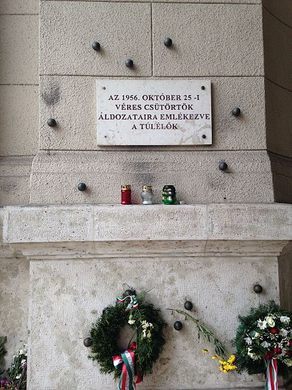

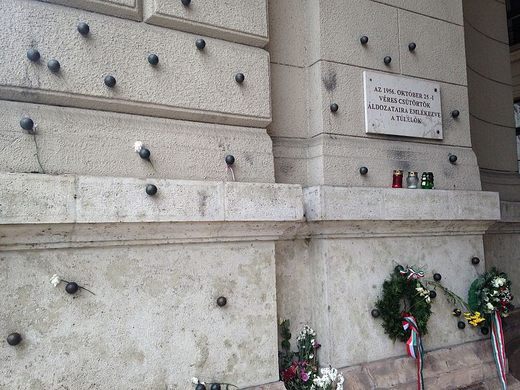
It’s unclear how many died during the massacre at Kossuth Lajos Square—sources vary, citing between 22 and 1000 deaths. And despite the bloody two-week revolution, the Hungarians’ bid for autonomy was ultimately squelched by Soviet reinforcements in November of 1956.
Today, dozens of bronze balls, each only slightly smaller than a tennis ball, demarcate where bullet holes from the revolution once riddled the outer wall of the building’s arcade.
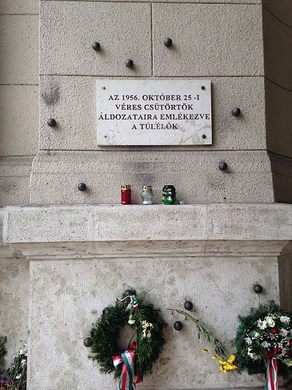
Clancy's comment: Mm ... a not so subtle reminder, eh?
I'm ...


3 May 2022 - GREAT PLAGUE OF LONDON
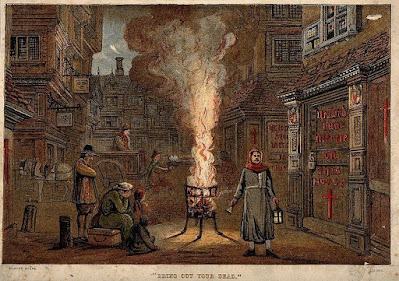
GREAT PLAGUE
OF LONDON
G'day folks,
In 1665 and 1666, the last great outbreak of bubonic plague to hit England swept through the capital, London.
The outbreak was much smaller in scale than the Black Death of the 14th century, but was still notable for having killed as many as 100,000 people - about a quarter of the city's population - in eighteen months.
By July 1665 the plague was spreading rapidly in London. Many fled, including the King Charles II, if they were wealthy enough to afford it. Parliament was moved to Oxford University from Westminster Palace. Many of the city's businesses closed. Diarist Samuel Pepys wrote much about life in the city during the plague, and of empty streets.
By September, as many as 7,000 people a week were dying, and many were thrown into mass graves. The true toll was likely to be much higher, since the deaths of poor were not recorded.
The University of Cambridge closed down during the outbreak, forcing a young Isaac Newton to continue his studies from home - during this time he expanded significantly on his new idea about the laws of gravity, among other things.
By November the outbreak started to taper off, and the King returned in February the next year when it was considered to be safe enough. Disaster would strike London again in 1666, with much of it being destroyed in the Great Fire of London that September.

Clancy's comment: Mm ... sound familiar?
I'm ...

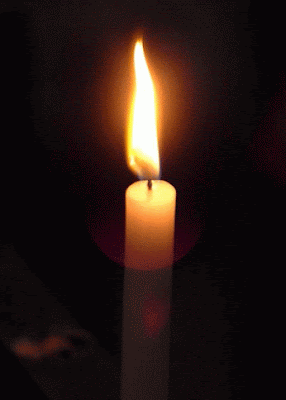
2 May 2022 - CASTEL MEUR - FRANCE

CASTEL MEUR
- FRANCE -
G'day folks,
Here, a small house sits between two huge rocks, with its back to the sea.Castel Meur, a small stone cottage in Plougrescant, France, was built in 1861 in a precarious position at the tip of the peninsula. At the time, construction was much less regulated and more riskily undertaken. To protect it from the frequently violent coastal weather, the house was positioned with its back to the sea and flanked on either side by two giant boulders.
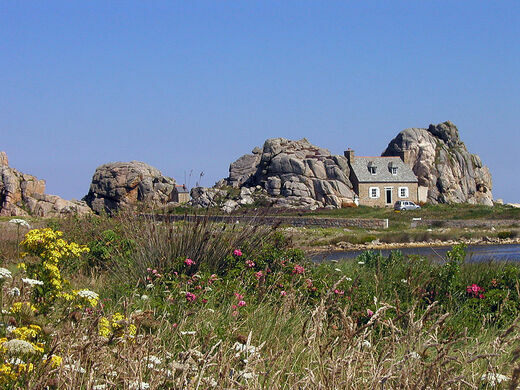

The unusually located cottage became known as the House Between Two Rocks. It has been passed down through the generations and is currently a private home. Its use in tourism campaigns to attract visitors to Plougrescant, specifically one world-famous postcard, became a problem when the house gained fame as a tourist attraction and tourists treated it as though nobody lived in it, some even climbing on it and damaging its roof.
The owner took legal action and won image rights for the house, which can no longer be used in advertising to draw tourists to the region. A stone wall surrounds the property.

Clancy's comment: What a great spot for a writer, eh?
I'm ...


1 May 2022 - THE SECRET MISSION OF RUDOLF HESS

THE SECRET MISSION
OF RUDOLF HESS
G'day folks,
Hitler's deputy, Rudolf Hess, mysteriously parachuted into Scotland on this day intending to negotiate a peace deal with the British. He did so without the knowledge of the Führer, who was absolutely livid when he heard the news.
Hess had met the Duke of Hamilton at the Berlin Olympics in 1936 and learned that the duke was a member of a far-right group who were interested in a "German-English agreement."
He hoped that Hamilton would arrange for him to meet King George VI, believing he could persuade the king to sack Winston Churchill, then Britain could make peace with Germany and join forces against the Soviet Union.
At 6,000 feet and within 30 miles of the duke's residence near Glasgow, Hess bailed out of the Messerschmitt that he had piloted by himself and parachuted safely to the ground. His first contact was a Scottish farmer who was told in English by Hess: "I have an important message for the Duke of Hamilton."
Interrogated at an army barracks, he proposed that the British should allow Germany to dominate Europe, in return for which the British Empire would be safe from attack by Adolf Hitler. He insisted that German victory in the war was inevitable and threatened that the British people would be starved to death by a blockade around the country unless his generous peace offer was accepted.
Hitler quickly issued a statement saying that his deputy was mentally disordered and "a victim of hallucinations." He immediately stripped Hess of all the ranks he held in the Nazi party including being a party member and secretly ordered him shot on sight if he ever returned to Germany.
Hess was born Rudolf Walter Richard Hess in Alexandria, Egypt, in 1894, the son of a Bavarian wholesaler and exporter. He did not live in Germany until he was 14.
When the First World War broke out in 1914 he enlisted in the 7th Bavarian Field Artillery Regiment as an infantryman, was wounded several times and won the Iron Cross in 1915.
Sharing Hitler's stab-in-the-back notion that Germany's failure to win the 1914-18 war was caused by a conspiracy of Jews and Bolsheviks rather than a military defeat, Hess joined the Nazi party in 1920 and quickly became Hitler’s friend and confidant.
He was at Hitler’s side in November 1923 for the Beer Hall Putsch, a failed Nazi attempt to seize control of the government of Bavaria. While the pair were serving time in jail for this attempted coup, Hess helped Hitler write his book, Mein Kampf, which became a foundation of the Nazis' political platform.

After the Nazi seizure of power in 1933, Hess was appointed Deputy Führer and as well as appearing on Hitler’s behalf at speaking engagements and rallies, he signed into law much of the legislation that stripped German Jews of their rights.
Hess’s peace proposals met with no response from the British government and he was held prisoner until the end of the war.
In 1946 he was sent for trial at Nuremberg where he was acquitted on charges related to war crimes and crimes against humanity, but convicted of crimes against peace.
In his final speech to the judges he continued to display loyalty to Hitler, declaring: "It was granted me for many years to live and work under the greatest son whom my nation has brought forth in the thousand years of its history.
"Even if I could, I would not expunge this period from my existence. I regret nothing. If I were standing once more at the beginning I should act once again as I did then, even if I knew that at the end I should be burnt at the stake."
He was sentenced to life imprisonment and with other Nazi leaders sent to Spandau Prison in Berlin. After 1966 he was the only prisoner there. Hess was held as Prisoner No. 7, always denied parole, and hanged himself in the grounds of the jail on 17 August 1987 at the age of ninety-three.
After his death the prison was demolished to prevent it from becoming a neo-Nazi shrine.

Clancy's comment: A sad tale of a sad time. Lest we forget those who perished.
I'm ...


30 April 2022 - VOLUNTEERS DEFEAT GENERAL STRIKE IN UK
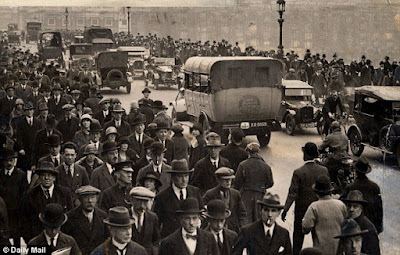
VOLUNTEERS DEFEAT
GENERAL STRIKE IN UK
G'day folks,
Britain's first and only General Strike began at one minute before midnight on 3 May 1926. It lasted for just ten days.
The strike was called by the Trades Union Congress (TUC) in support of coal miners who had been told that their wages were to be reduced by 13 per cent and the length of their shifts increased from seven to eight hours.
In response, miners in the North of England, Scotland and Wales went on strike, marching to the slogan: “Not a minute on the day, not a penny off the pay.”
In London, a trigger event for the General Strike came when printers at the Daily Mail in Fleet Street refused to print a leading article criticising trade unions. Shortly afterwards the TUC called out all of its members in essential industries.
The result was that an estimated 1.75 million people across the country stopped work. They included dockers, printers, power station workers, railwaymen and transport staff. The TUC’s aim was to bring the capital to a halt and so force the Government to act on behalf of the miners.
It didn’t work out that way. Society was bitterly divided by the strike, many people outraged by the TUC “holding a pistol to the nation’s head.” Volunteers moved in and some of London's buses, trams, trains and delivery vans were kept running by non-unionised workers and university students.
Generally, though, the transport network was crippled without its regular bus and train drivers, and roads became choked with cars. Food deliveries were held up. Fights broke out between police and strikers in cities across the UK and in some places police charged rioting strikers with batons.
In a radio broadcast Conservative Prime Minister Stanley Baldwin made a heartfelt plea: "I am a man of peace. I am longing, and looking and praying for peace. But I will not surrender the safety and the security of the British constitution.
"Cannot you trust me to ensure a square deal and to ensure even justice between man and man?"
It seemed not and even though the Roman Catholic Church branded the strike a sin, it rumbled on. As it did so the Army escorted food lorries and set up barracks in Hyde Park, where a milk and food depot was created.

Because the printers were on strike most newspapers appeared in a very brief form, if at all. But to help get the Government’s message across, Winston Churchill, Chancellor of the Exchequer at the time, pioneered a new newspaper, the British Gazette, which he edited. It was printed in Paris and flown to London daily.
It ran to only eight editions but the circulation rose from an initial 200,000 to 2,000,000 and it proved to be an effective propaganda tool for the Government.
Meanwhile, talks between the TUC and ministers continued to take place regularly at 10 Downing Street. On 13 May, union leaders, recognising that the country was muddling through despite the strike, called it off – much to the anger of many miners. They were to remain locked out until September and in the end gained nothing from the dispute.
A year later, Stanley Baldwin passed a new law that effectively outlawed the sympathetic strike action and mass picketing that had created the General Strike. It was repealed by a Labour Government in 1946, but in the 1980s Margaret Thatcher reintroduced the ban, which is still in force today.
After the country got back to normal, a debate took place in Parliament on whether the taxpayer should bear the costs of the British Gazette and a Labour MP speculated on what would happen in a future general strike.
Churchill rose to his feet and declared: "Make your minds perfectly clear that if ever you let loose upon us again a general strike, we will loose upon you (pause) another British Gazette!"
The comment drew laughter and applause from both sides.

Clancy's comment: An interesting move by Churchill.
I'm ...


March 5, 2022
29 April 2022 - VINH MOC TUNNEL COMPLEX - VIETNAM

VINH MOC TUNNEL
COMPLEX
- VIETNAM -
G'day folks,
This network of tunnels housed an entire village for years, and even had a hall for screening movies.There are a handful of Vietnamese men and women, roughly in their early 40s, who share a very unusual distinction: They were born in the Vinh Moc tunnel complex in the Quang Tri region, while their families took shelter from bombs raining down on their village during the Vietnam War.
The tunnel network was created in the Vietnamese Demilitarized Zone in 1965-66, starting at 32 feet (10 meters) underground. The U.S. military believed that the residents of Vinh Moc were supplying food and ammunition to Con Co island, a nearby North Vietnamese military base; to force the villagers to move out, American forces rained up to 500 rockets a day on the region. Instead of fleeing, the villagers went underground.


What began as a few tunnels expanded to a network of around 5,200 feet (1600 meters), with 13 entrances leading from the beach and inland hills. The tunnels were divided into three levels, the deepest at 75 feet (23 meters) deep. Around 400 people from 60 families frequently took refuge there until 1972; their longest continuous stay underground was for 18 months.
Today the tunnels function as a museum. Visitors can see how the two lower levels housed the family quarters. There was a communal kitchen and washrooms, a maternity room, lookout posts, and even an 80-person meeting hall where films were screened, all carved out of hardened clay. One of the key architects of the caves was Le Xuan Vy, whose first son was born in the caves in 1967.
While life and birth went on for months and years underground, the huts and buildings in Vinh Moc were leveled. But the tunnel complex served its purpose—no lives were lost in the subterranean village.

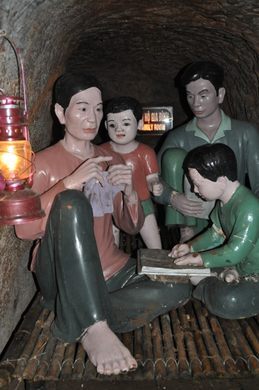
Clancy's comment: Extraordinary and resourceful people.
I'm ...





